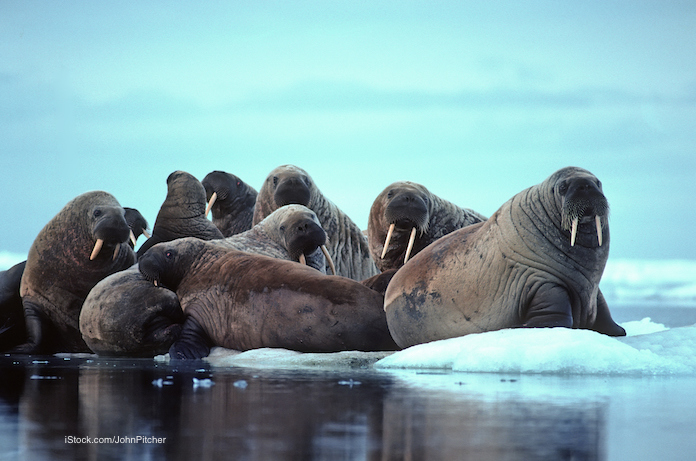Many older people can recall their moms cooking pork to well done (or more) because of the fear of trichinellosis. Pigs used to be fed scraps, or they foraged for their food, so their meat was infected with a microscopic parasite called Trichinella. A few thousand cases occur every year around the world.

In the United States, the USDA has reduced the recommended internal temperature for pork to 145°F from 160°F, since pork is no longer likely to be contaminated with the parasite. Cases have greatly declined in this country since the 1950s. But the disease is making a comeback among people who eat walrus meat.
Two trichinellosis outbreaks in Alaska linked to walrus meat are the subject of a report in the CDC’s Morbidity and Mortality Weekly Report for July 7, 2017. This illness has been most commonly associated with raw or undercooked pork products, since pigs used to be fed scraps or foraged, but now, non porcine wild game species have been implicated.
During 1975 – 2012, the CDC identified 1,680 cases of trichinellosis in the U.S. Among those, 1,219 were attributed to raw or pork products, and 461 to non pork products. During July 2016 – May 2016 the Alaska Division of Public Health investigated two outbreaks in the Norton Sound region. Five cases were identified in each outbreak. These were the first multiple-case outbreaks of walrus-associated trichinellosis in Alaska since 1992.
The index patient was an adolescent female. She experienced severe lower extremity edema and pain, difficulty walking, a rash, weakness, fever, and myalgia (muscle pain) on August 15, 2016. Her brother and father were also evaluated; blood tests found that all of them had eosinophilia, a sign of parasitic infection. All of the patients said they consumed raw or pan-fried to medium walrus meat on July 17.
Two more patients were diagnosed from the same community on September 19, 2017. Both reported muscle pains and fatigue beginning about 1 week after eating walrus meat. Leftover walrus meat was not available for lab tests, and investigators could not determine where the walrus was harvested, if the meat had been shared, or if all five of the patients had eaten from the same animal.
The risk of contracting trichinellosis when wild game is cooked to at least 160°F as measured with a meat thermometer. The parasite can’t be killed by smoking, drying, or fermenting meat, and the arctic species of Trichinella is freeze tolerant. All five patients recovered.
The second outbreak was discovered on May 12, 2017, with another suspected case in a second Norton Sound coastal community. The first patient was an adult male who was experiencing serious muscle and joint pain. Four other suspected cases were diagnosed based on reported illness or exposure through a shared meal of undercooked walrus meat on April 25, 2017.
In this outbreak, the person who prepared the walrus meat said she boiled it for about 1 hour. The exterior was fully cooked, but the interior was undercooked or raw. Many people in that community prefer the taste and texture of undercooked or raw walrus meat to fully cooked meat.
Again, no meat from the implicated meal was available for testing, but officials collected a “convenience sample” of meat from 11 bags that were stored in a freezer. One sample tested positive for the larvae of Trichinella.
All patients from these outbreaks made a full recovery. They were treated with antibiotics.
These outbreaks highlight the importance of culturally relevant public health messaging. In areas where while game is harvested and eaten, traditional methods may have cultural significance, but can cause illness.




